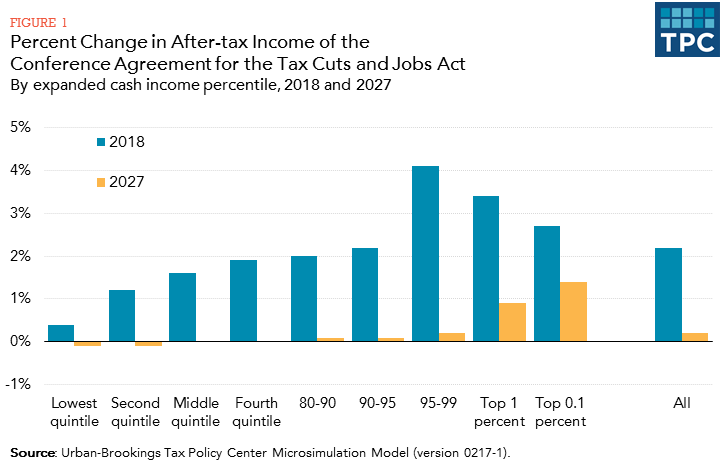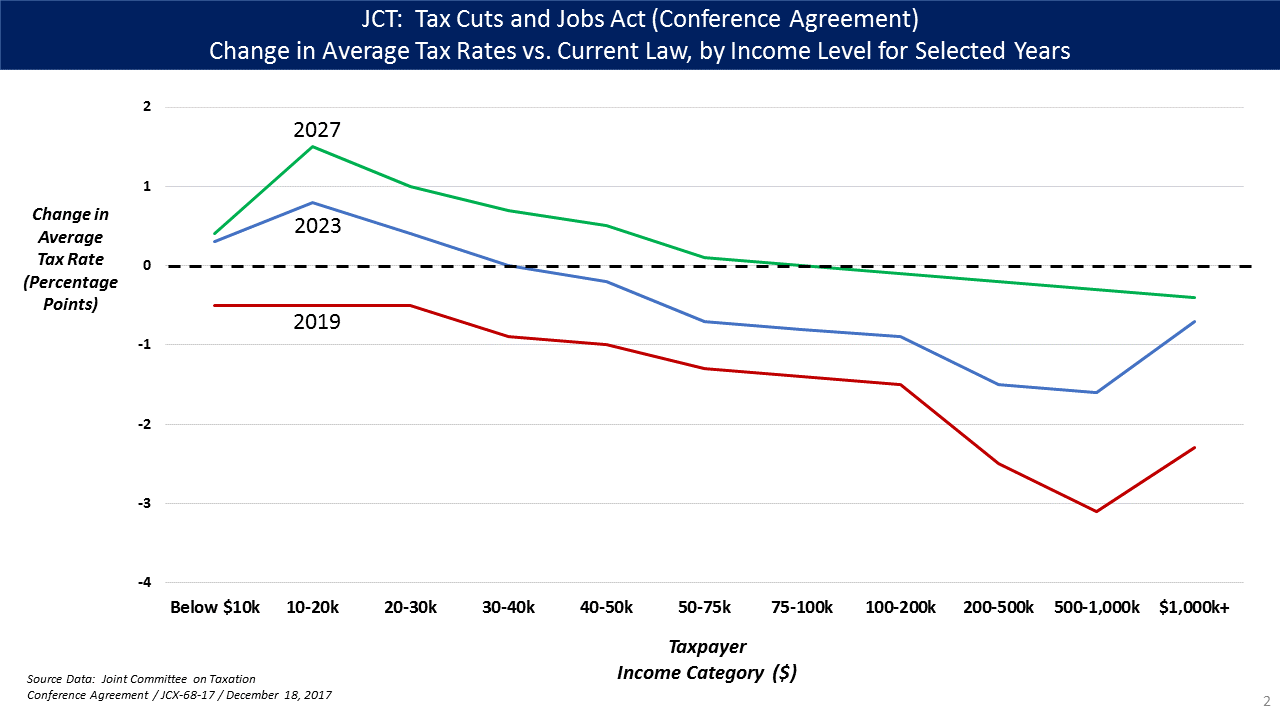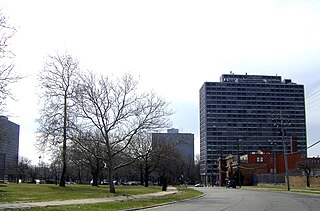read more...
"The CBO estimates that implementing the Act would add an estimated $2.289 trillion to the national debt over ten years, or about $1.891 trillion after taking into account macroeconomic feedback effects..."
"The individual and pass-through tax cuts fade over time and become net tax increases starting in 2027 while the corporate tax cuts are permanent."
"Most individual income taxes are reduced, until 2025. The number of income tax brackets remain at seven, but the income ranges in several brackets have been changed and each new bracket has lower rates."
"A different inflation measure (Chained CPI or C-CPI) will be applied to the brackets instead of the Consumer Price Index (CPI), so the brackets increase more slowly. This is effectively a tax increase over time, as people move more quickly into higher brackets as their income rises; this element is permanent."
"Fewer people will pay the Alternative minimum tax because the act increases the exemption level from $84,500 to $109,400 for married taxpayers filing jointly and from $54,300 to $70,300 for single taxpayers."
"For deaths occurring between 2018 and 2025, estates that exceed $11.2 million are subject to a 40% estate tax at time of death, increased from $5.6 million previously."
"The corporate tax rate was lowered from 35% to 21%, while some related business deductions and credits were reduced or eliminated."
"The Act contains provisions that would open 1.5 million acres (6,100 km2) in the Arctic National Wildlife Refuge to oil and gas drilling." [This was done to secure a vote from Senator Lisa Murkowski.]
"The nonpartisan Joint Committee on Taxation also estimated that the GDP level would be 0.7% higher (in aggregate, not per annum) during the 2018–2027 period relative to the CBO baseline forecast, employment level would be 0.6% higher and personal consumption level would be 0.6% higher during the 2018–2027 period on average due to the Act."
"These are higher levels, not higher annual growth rates, so these are relatively minor economic impacts over 10 years."
"During 2019, income groups earning under $20,000 (about 23% of taxpayers) would contribute to deficit reduction (i.e. incur a cost), mainly by receiving fewer subsidies due to the repeal of the individual mandate of the Affordable Care Act." "Other groups would contribute to deficit increases (i.e. receive a benefit), mainly due to tax cuts."
"During 2021, 2023 and 2025, income groups earning under $40,000 (about 43% of taxpayers) would contribute to deficit reduction (tax increases), while income groups above $40,000 would contribute to deficit increases."
"During 2027, income groups earning under $75,000 (about 76% of taxpayers) would contribute to deficit reduction while income groups above $75,000 would contribute to deficit increases"
"The Tax Policy Center (TPC) estimated that the bottom 80% of taxpayers (income under $149,400) would receive 35% of the benefit in 2018, 34% in 2025 and none of the benefit in 2027, with some groups incurring costs."
"Bloomberg reported (based on an analysis of 51 S&P 500 companies) that an estimated 60% of corporate tax savings was going to shareholders, while 15% was going to employees."
"The law also impacts healthcare by repealing the ACA individual mandate, resulting in projections of up to 13 million fewer persons covered by health insurance as some younger, healthier persons will likely choose not to participate."
"Those in the remaining less healthy pool will pay higher insurance costs on the ACA exchanges, which will result in additional persons dropping coverage."
"The Committee for a Responsible Federal Budget (CRFB) summarized several studies that indicated a boost to annual GDP growth rates would be about 0.1% each year rather than the Administration's claims of 0.4% per year."
"CBO reported that the budget deficit was $779 billion in fiscal year 2018, up $113 billion or 17% from 2017."
"The Tax Policy Center (TPC) reported its distributional estimates for the Act. This analysis excludes the impact from repealing the ACA individual mandate, which would apply significant costs primarily to income groups below $40,000."
"Compared to current law, 5% of taxpayers would pay more in 2018, 9% in 2025, and 53% in 2027."
"The top 1% of taxpayers (income over $732,800) would receive 8% of the benefit in 2018, 25% in 2025, and 83% in 2027."
"The top 5% (income over $307,900) would receive 43% of the benefit in 2018, 47% in 2025, and 99% in 2027."
"The top 20% (income over $149,400) would receive 65% of the benefit in 2018, 66% in 2025 and all of the benefit in 2027."
"The bottom 80% (income under $149,400) would receive 35% of the benefit in 2018, 34% in 2025 and none of the benefit in 2027, with some groups incurring costs."
"The third quintile (taxpayers in the 40th to 60th percentile with income between $48,600 and $86,100, a proxy for the "middle class") would receive 11% of the benefit in 2018 and 2025, but would incur a net cost in 2027."
"After taxes and transfers, the income of the top 1% would grow more than other income groups, continuing previous trends."
"The Gini Index would rise, indicating increasing inequality, reversing a trend from the latter part of the Obama administration."
"According to the CBO, under the Senate version of the bill, businesses receive a $890 billion benefit or 63%, individuals $441 billion or 31%, and estates $83 billion or 6%."
"Later in 2019, the Economic Policy Institute analyzed the data on business investment from the federal Bureau of Economic Analysis and concluded that, 'if the TCJA’s corporate rate cuts were working, we would be seeing a permanent rise in investment. Instead, investment growth is cratering.'"
"The analysis also found that since the tax cut firms increased dividends and stock buybacks by nearly three times as much as they increased capital investments." (38/)
"A January 2018 study from the firm Willis Towers Watson found that 80% of companies were not "considering giving raises at all.'"
"In 2027, if the tax cuts are paid for by spending cuts borne evenly by all families, after-tax income would be 3.0% higher for the top 0.1%, 1.5% higher for the top 10%, -0.6% for the middle 40% (30th to 70th percentile) and -2.0% for the bottom 50%."
"The individual and pass-through tax cuts fade over time and become net tax increases starting in 2027 while the corporate tax cuts are permanent."
"Most individual income taxes are reduced, until 2025. The number of income tax brackets remain at seven, but the income ranges in several brackets have been changed and each new bracket has lower rates."
"A different inflation measure (Chained CPI or C-CPI) will be applied to the brackets instead of the Consumer Price Index (CPI), so the brackets increase more slowly. This is effectively a tax increase over time, as people move more quickly into higher brackets as their income rises; this element is permanent."
"Fewer people will pay the Alternative minimum tax because the act increases the exemption level from $84,500 to $109,400 for married taxpayers filing jointly and from $54,300 to $70,300 for single taxpayers."
"For deaths occurring between 2018 and 2025, estates that exceed $11.2 million are subject to a 40% estate tax at time of death, increased from $5.6 million previously."
"The corporate tax rate was lowered from 35% to 21%, while some related business deductions and credits were reduced or eliminated."
"The Act contains provisions that would open 1.5 million acres (6,100 km2) in the Arctic National Wildlife Refuge to oil and gas drilling." [This was done to secure a vote from Senator Lisa Murkowski.]
"The nonpartisan Joint Committee on Taxation also estimated that the GDP level would be 0.7% higher (in aggregate, not per annum) during the 2018–2027 period relative to the CBO baseline forecast, employment level would be 0.6% higher and personal consumption level would be 0.6% higher during the 2018–2027 period on average due to the Act."
"These are higher levels, not higher annual growth rates, so these are relatively minor economic impacts over 10 years."
"During 2019, income groups earning under $20,000 (about 23% of taxpayers) would contribute to deficit reduction (i.e. incur a cost), mainly by receiving fewer subsidies due to the repeal of the individual mandate of the Affordable Care Act." "Other groups would contribute to deficit increases (i.e. receive a benefit), mainly due to tax cuts."
"During 2021, 2023 and 2025, income groups earning under $40,000 (about 43% of taxpayers) would contribute to deficit reduction (tax increases), while income groups above $40,000 would contribute to deficit increases."
"During 2027, income groups earning under $75,000 (about 76% of taxpayers) would contribute to deficit reduction while income groups above $75,000 would contribute to deficit increases"
"The Tax Policy Center (TPC) estimated that the bottom 80% of taxpayers (income under $149,400) would receive 35% of the benefit in 2018, 34% in 2025 and none of the benefit in 2027, with some groups incurring costs."
"Bloomberg reported (based on an analysis of 51 S&P 500 companies) that an estimated 60% of corporate tax savings was going to shareholders, while 15% was going to employees."
"The law also impacts healthcare by repealing the ACA individual mandate, resulting in projections of up to 13 million fewer persons covered by health insurance as some younger, healthier persons will likely choose not to participate."
"Those in the remaining less healthy pool will pay higher insurance costs on the ACA exchanges, which will result in additional persons dropping coverage."
"The Committee for a Responsible Federal Budget (CRFB) summarized several studies that indicated a boost to annual GDP growth rates would be about 0.1% each year rather than the Administration's claims of 0.4% per year."
"CBO reported that the budget deficit was $779 billion in fiscal year 2018, up $113 billion or 17% from 2017."
"The Tax Policy Center (TPC) reported its distributional estimates for the Act. This analysis excludes the impact from repealing the ACA individual mandate, which would apply significant costs primarily to income groups below $40,000."
"Compared to current law, 5% of taxpayers would pay more in 2018, 9% in 2025, and 53% in 2027."
"The top 1% of taxpayers (income over $732,800) would receive 8% of the benefit in 2018, 25% in 2025, and 83% in 2027."
"The top 5% (income over $307,900) would receive 43% of the benefit in 2018, 47% in 2025, and 99% in 2027."
"The top 20% (income over $149,400) would receive 65% of the benefit in 2018, 66% in 2025 and all of the benefit in 2027."
"The bottom 80% (income under $149,400) would receive 35% of the benefit in 2018, 34% in 2025 and none of the benefit in 2027, with some groups incurring costs."
"The third quintile (taxpayers in the 40th to 60th percentile with income between $48,600 and $86,100, a proxy for the "middle class") would receive 11% of the benefit in 2018 and 2025, but would incur a net cost in 2027."
"After taxes and transfers, the income of the top 1% would grow more than other income groups, continuing previous trends."
"The Gini Index would rise, indicating increasing inequality, reversing a trend from the latter part of the Obama administration."
"According to the CBO, under the Senate version of the bill, businesses receive a $890 billion benefit or 63%, individuals $441 billion or 31%, and estates $83 billion or 6%."
"Later in 2019, the Economic Policy Institute analyzed the data on business investment from the federal Bureau of Economic Analysis and concluded that, 'if the TCJA’s corporate rate cuts were working, we would be seeing a permanent rise in investment. Instead, investment growth is cratering.'"
"The analysis also found that since the tax cut firms increased dividends and stock buybacks by nearly three times as much as they increased capital investments." (38/)
"A January 2018 study from the firm Willis Towers Watson found that 80% of companies were not "considering giving raises at all.'"
"In 2027, if the tax cuts are paid for by spending cuts borne evenly by all families, after-tax income would be 3.0% higher for the top 0.1%, 1.5% higher for the top 10%, -0.6% for the middle 40% (30th to 70th percentile) and -2.0% for the bottom 50%."













